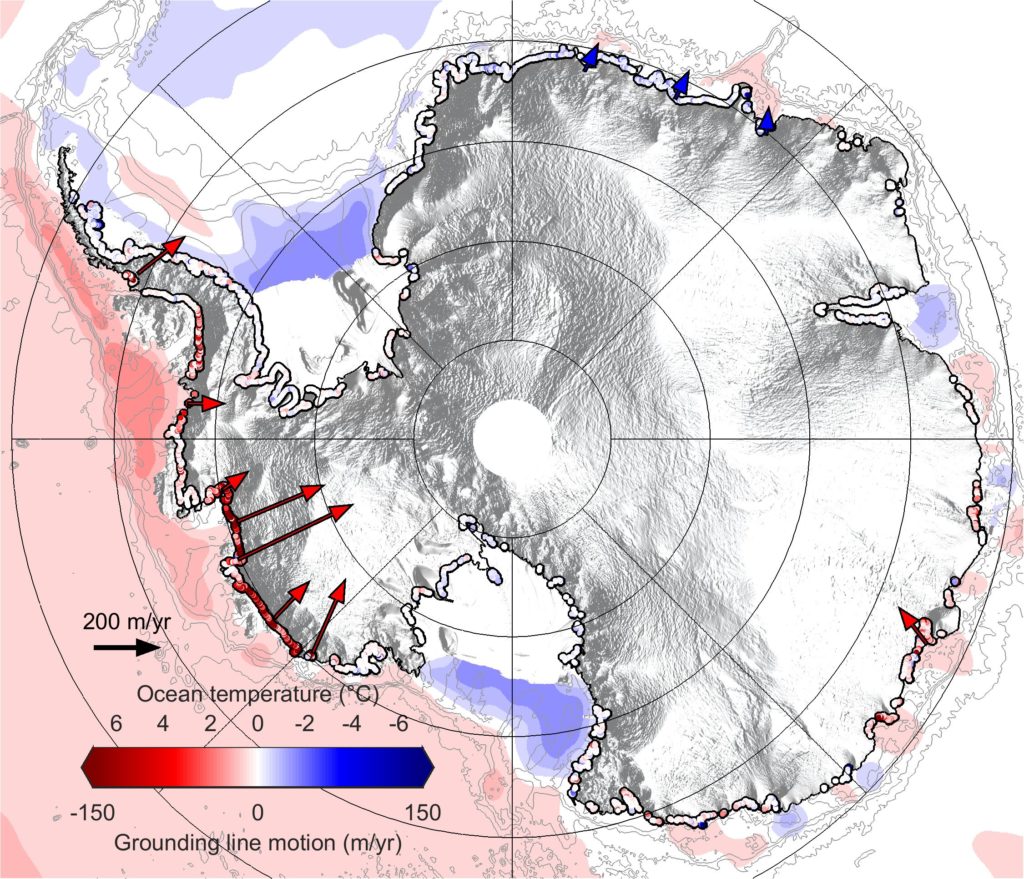Antarctica’s great ice sheet is losing ground as it is eroded by warm ocean water circulating beneath its floating edge, a new study has found.
Research by CPOM at the University of Leeds has produced the first complete map of how the ice sheet’s submarine edge, or “grounding line”, is shifting. Most Antarctic glaciers flow straight into the ocean in deep submarine troughs, the grounding line is the place where their base leaves the sea floor and begins to float.
The study, published today in Nature Geoscience, shows that the Southern Ocean melted 1,463 km2 of Antarctica’s underwater ice between 2010 and 2016 – an area the size of Greater London.

Map showing rates of grounding line migration and their coincidence with ocean conditions around Antarctica between 2010 and 2016 (seabed temperatures: Locarnini et al., 2013. World Ocean Atlas 2013, Volume 1: Temperature. S. Levitus, Ed., A. Mishonov Technical Ed.; NOAA Atlas NESDIS 73, 40 pp.). Grounding line locations are from Rignot et al., 2013, Science 341 (6143), pp. 266-270.
Credit: Konrad et al.
The team, led by Dr Hannes Konrad, found that grounding line retreat has been extreme at eight of the ice sheet’s 65 biggest glaciers. The pace of deglaciation since the last ice age is roughly 25 metres per year. The retreat of the grounding line at these glaciers is more than five times that rate.
The biggest changes were seen in West Antarctica, where more than a fifth of the ice sheet has retreated across the sea floor faster than the pace of deglaciation.
Dr Konrad said: “Our study provides clear evidence that retreat is happening across the ice sheet due to ocean melting at its base, and not just at the few spots that have been mapped before now. This retreat has had a huge impact on inland glaciers, because releasing them from the sea bed removes friction, causing them to speed up and contribute to global sea level rise.”
The researchers also found some unexpected behaviour. Although retreat of the Thwaites Glacier grounding line in West Antarctica has sped up, at the neighbouring Pine Island Glacier – until recently one of the fastest retreating on the continent – it has halted. This suggests that the ocean melting at its base may have paused.
Dr Konrad added: “These differences emphasise the complex nature of ice sheet instability across the continent, and being able to detect them helps us to pinpoint areas that deserve further investigation.”
Grounding lines typically lie a kilometre or more below sea level and are inaccessible even to submersibles, so remote sensing methods for detecting them are extremely valuable.
The team were able to track the movement of Antarctica’s grounding line using European Space Agency’s CryoSat-2 across 16,000 km of the coastline. Although CryoSat-2 is designed to measure changes in the ice sheet elevation, these can be translated into horizontal motion at the grounding line using knowledge of the glacier and sea floor geometry and the Archimedes principle of buoyancy – which relates the thickness of floating ice to the height of its surface.
Study co-author Professor Andy Shepherd said: “We were delighted at how well CryoSat-2 is able to detect the motion of Antarctica’s grounding lines. They are impossible places to access from below, and usually invisible on the ground, so it’s a fantastic illustration of the value of satellite measurements for identifying and understanding environmental change.”
Further information:
Images and animation are available for download: https://goo.gl/JXkX24
The paper Net retreat of Antarctic glacier grounding lines by Hannes Konrad, Andrew Shepherd, Lin Gilbert, Anna Hogg, Malcolm McMillan, Alan Muir and Thomas Slater is published 2 April in Nature Geoscience (doi:10.1038/s41561-018-0082-z).
Dr Konrad (hannes.konrad@awi.de) and Professor Shepherd (a.shepherd@leeds.ac.uk) are available for comment. Dr Konrad is now based at the Alfred Wegener Institute in Germany. Professor Shepherd is CPOM Director and Principal Scientific Advisor to ESA’s CryoSat-2 mission.
